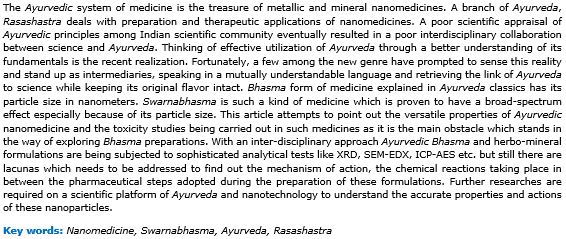Ayurvedic Nanomedicine (Swarna Bhasma) - Evaluation based on Analytical Parameters
Keywords:
Nanomedicine, Swarnabhasma, Ayurveda, RasashastraAbstract
The Ayurvedic system of medicine is the treasure of metallic and mineral nanomedicines. A branch of Ayurveda, Rasashastra deals with preparation and therapeutic applications of nanomedicines. A poor scientific appraisal of Ayurvedic principles among Indian scientific community eventually resulted in a poor interdisciplinary collaboration between science and Ayurveda. Thinking of effective utilization of Ayurveda through a better understanding of its fundamentals is the recent realization. Fortunately, a few among the new genre have prompted to sense this reality and stand up as intermediaries, speaking in a mutually understandable language and retrieving the link of Ayurveda to science while keeping its original flavor intact. Bhasma form of medicine explained in Ayurveda classics has its particle size in nanometers. Swarnabhasma is such a kind of medicine which is proven to have a broad-spectrum effect especially because of its particle size. This article attempts to point out the versatile properties of Ayurvedic nanomedicine and the toxicity studies being carried out in such medicines as it is the main obstacle which stands in the way of exploring Bhasma preparations. With an inter-disciplinary approach Ayurvedic Bhasma and herbo-mineral formulations are being subjected to sophisticated analytical tests like XRD, SEM-EDX, ICP-AES etc. but still there are lacunas which needs to be addressed to find out the mechanism of action, the chemical reactions taking place in between the pharmaceutical steps adopted during the preparation of these formulations. Further researches are required on a scientific platform of Ayurveda and nanotechnology to understand the accurate properties and actions of these nanoparticles.
Downloads
References
Sarkar, P.K., Chaudhary, A.K.: Ayurvedic Bhasma: the most ancient application of nanomedicine. J. Sci. Ind. Res. 69, 901–905 (2010) 31. Prajapati, P.K., Sarkar, P.K., Nayak,
S.V., Joshi, R.D., Ravishankar, B.: Safety and toxicity profle of some metallic preparations of Ayurveda. Anc. Sci. Life. 25(3), 57–66 (2006)
Indian medicine.nic.in [homepage on the Internet]. India: Dept of AYUSH, Govt of India Available from: http://www. indianmedicine.nic.in. [last updated on 2008]. [last accessed on 2008 Aug 11].
Hankey A. CAM modalities can stimulate advances in theoretical biology. Evid Based Complement Alternat Med 2005;2:5–12.
Hankey A. The scientifi c value of Ayurveda. J Altern Complement Med 2005;11:221–5.
Sahoo SK, Parveen S, Panda JJ. The present and future of nanotechnology in human health care. Nanomedicine 2007; 3 (1): 20-31.
Sandhiya S, Dkhar SA, Surendiran A. Emerging trends of nanomedicine-an overview. Fundam Clin Pharmacol 2009; 23 (3); 263-9.
Koo OM, Rubinstein I, Onyuksel H. Role of nanotechnology in targeted drug delivery and imaging: A concise review. Nanomedicine 2005; 1 (3): 193-212.
Chakraborty M, Jain S, Rani V. Nanotechnology: Emerging tool for diagnostics and therapeutics. Appl Biochem Biotechnol 2011; 165 (11): 1178-87.
Mahajan M, Khurana RK, Singh H, et al. An overview of current applications of nanotechnology in biomedical research: A patent Survey. Recent Pat Nanomed 2014; 4: 46-56.
Enhanced Internalization of Indian Ayurvedic Swarna Bhasma (Gold Nanopowder) for Effective Interaction with Human Cells
Assessment of bioavailability of gold bhasma in human participants e A pilot study. Journal of Ayurveda and Integrative Medicine journal homepage: http://elsevier.com/locate/jaim)
Comparative study on cellular entry of incinerated ancient gold particles (Swarna Bhasma) and chemically synthesized gold particles (Scientific reports)
Evaluation of chemical constituents and free-radical scavenging activity of Swarnabhasma (gold ash), an ayurvedic drug (Evaluation of chemical constituents and free-radical scavenging activity of Swarnabhasma (gold ash), an ayurvedic drug)
Toxicity Study of Swarna Bhasma, an Ayurvedic Medicine Containing Gold, in Wistar Rats
Beaudet, D., Badiles, S., Kuruvinashetti, K., Kashani, A.S., Jaunky, D., Ouellette, S., Piekny, A., Packirisamy, M.: Comparative study on cellular entry of incinerated ancient gold particles (Swarna Bhasma) and chemically synthesized gold particles. Sci. Rep. 7, 1–12 (2017)
Sharma, R., Bhatt, A., Thakur, M.: Physicochemical characterization and antibacterial activity of Rajata Bhasma and silver nanoparticle. AYU. 37, 71–75 (2016)
Singh, R.K., Kumar, S., Aman, A.K., Karim, S.M., Kumar, S., Kar, M.: Study on physical properties of Ayurvedic nanocrystalline Tamra Bhasma by employing modern scientifc tools. J. Ayurveda Integr. Med. 10(2), 1–6 (2017)
Singh, T.R., Gupta, L.N., Kumar, N.: Standard manufacturing procedure of Teekshna Lauha Bhasma. J. Ayurveda Integr. Med. 7, 100–108 (2016)
Nagarajan, S., Krishnaswamy, S., Pemiah, B., Rajan, S., Krishnan, U., Sethuraman, S.: Scientifc insights in the preparation and characterization of a lead-based Naga Bhasma. Indian J. Pharm. Sci. 76(1), 38–45 (2014)
Kale, B., Rajurkar, N.: Synthesis and characterization of Vanga Bhasma. J. Ayurveda Integr. Med. 10(2), 1–9 (2017)
Chavare, A., Chowdari, P., Ghosh, S., Pawar, P., Patkar, M., Dakave, S., Gota, V., Chaudhari, P., Chiplunkar, S.V., Kane, S., Suresh, A.K., Bellare, J.: Safety and bioactivity studies of Jasad Bhasma and its in-process intermediate in Swiss mice. J. Ethnopharmacol. 197, 73–86 (2017)
Brown C, Bushell G R, Whitehouse M, Agrawal DS, Tupe SG, Paknikar KM, et al. Nano gold pharmaceutics(i) The use of colloidal gold to treat experimentally-induced arthritis in rat models;(ii) Characterization of the gold in Swarna Bhasma, a microparticulate used in traditional Indian medicine, Gold 2006 presentation, Gold Bulletin 2007;40:3.
Rediffnews.com [Home page on internet] 18 Ayurvedic drugs violate norms: report. Available from: http:// www. rediffnews.com [last updated on 2005 Dec 9]. [last accessed on 2008 Aug 15].
Singh SK, Chaudhari A, Rai DK, Rai SB. Preparation and characterization of a mercury based Indian traditional drug Ras-Sindoor. Indian J Traditional Knowledge 2009;8:346-51.
Pyrgiotakis G, Bhowmick TK, Finton K, et al. A study of cell (A549) - particle (Jasada Bhasma) interactions using Raman spectroscopy 2008; Biopolymers, Wiley Periodicals, Inc; 2008. 10.1002/bip.20947.
Mukherjee P, Bhattacharya R, Bone N, Lee YK, Patra CR, Wang S, et al. Potential therapeutic application of gold nanoparticles in B-chronic lymphocytic leukemia (BCLL): enhancing apoptosis. J Nanobiotechnology 2007; 5:4.
Kulkarni DA, editor. Rasa Ratna Samucchaya. New Delhi: Mehar Das Laxman das Publications; 1998. p. 10/48-50.















